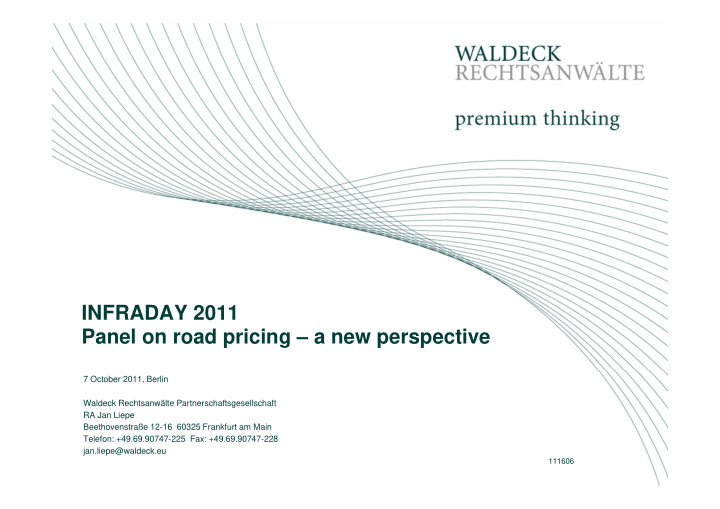



INFRADAY 2011 Panel on road pricing – a new perspective 7 October 2011, Berlin Waldeck Rechtsanwälte Partnerschaftsgesellschaft RA Jan Liepe Beethovenstraße 12-16 60325 Frankfurt am Main Telefon: +49.69.90747-225 Fax: +49.69.90747-228 jan.liepe@waldeck.eu 111606
HGV charging affects three vital EU policy areas sustainable development cross-sector approach Environmental high level of protection protection user-pays principle freedom of movement system of undistorted Internal Transport competition Market principle of non- mainly serving function discrimination implementation of freedom of services in the transport sector strengthening territorial & economic cohesion 2
Key features of the Eurovignette-Directive 1999/62/EC application to HGVs of over 3,5 tonnes harmonisation of levy limitation to trans- systems European road network core elements choice between domestic and foreign distance-based tolls users must be treated and time-based user alike charges (vignettes) tolls may only be varied mark-up in within the limits of mountainous areas infrastructure cost-cap 3
Shortcomings of the present system Current levy-system fails to send right price signals to 1 induce environment-friendly behaviour and sustainable transport In most cases road users are all treated alike , 2 irrespective of the pollution or congestion they cause Tolls are limited to the recovery of infrastructure costs, 3 any variations must respect the “infrastructure cost-cap” Restriction to the trans-European road network bears 4 risks of inconsistent pricing structures and detour effects of international transport Failing to enable more efficient and greener road pricing triggers uncoordinated unilateral measures potentially 5 disrupting supply chains and creating disproportionate obstacles to the freedom of movement 4
Key features of the revised Eurovignette- Directive 2011 Tailored strategy on the internalisation of external costs of the road haulage sector Tolling as the instrument of choice to internalise 1 detrimental external effects of HGV traffic Internalisation of external costs of local air and noise 2 pollution by way of an external-cost charge in addition to the levying of infrastructure charges Detrimental effects of congestion may only be reflected as 3 a variations of the infrastructure charge ( infrastructure cost-cap and maximum flexibility thresholds apply ) Common methodology and upper ceilings for the 4 calculation of external cost-charges to avoid distortions of competition and undue overcharging of hauliers Implementation of the “polluter pays” principle by sending 5 right pricing signals to users scope extended beyond trans-European road network to 6 all classified motorways 5
Functioning of the new differentiated tolling system implemented by Directive 2011 only in areas with exposed traffic based population noise pollution external-cost charge and / or traffic based air pollution and / or return on capital and/or profit margin development based on principle of costs recovery of infrastructure operation infrastructure costs costs charge maintenance costs construction costs 6
Conversely, congestion costs may only be reflected within the infrastructure cost regime shall be varied according to EURO emission classes may be varied for the purpose of - reducing congestion variation - minimising infrastructure damage must respect - optimising the use of the infrastructure revenue infrastructure - promoting road safety neutrality / conditions for variation: charge infrastructure - cost-cap transparent, made public and available to all users on equal terms - application according to time of day, type of day or season - maximum 175%-flexibility threshold 7
Roadmap to a Single EU Transport Area The White Paper 2011 Initiatives on smart pricing Phase I (up to 2016) Restructure transport charges and taxes – wider application of the „ polluter pays “ and „ user pays “ principle The transport sector should bear the total costs of transport in terms of infrastructure an external costs Phase in a mandatory infrastructure charge for HGVs Evaluate existing car road charging schemes and their compatibility with the EU-Treaties. Develop guidelines for the application of internalisation charges to all vehicles and for all main externalities Proceed with the internalisation of external costs for all modes of transport applying common principles while taking into account specifics of each mode Create a framework for earmarking revenues form transport for the development of an integrated and efficient transport system Phase II (2016 to 2020) Proceed to the full and mandatory internalisation of external costs for road and rail transport 8
Recommend
More recommend